
What is adenoids? Where are they and for what are needed? Symptoms of adenoids in children.
The content of the article
- What is adenoids in children, where they look like, why are you needed, what are you dangerous? Glands and adenoids: what's the difference?
- Degree of adenoids in children: 1, 2, 3
- How to check adenoids in a child?
- Video: Endoscopy of the nasopharynx degree of adenoid
- How to determine, recognize adenoids in children: symptoms, signs
- Adenoids in infants: symptoms
- Adenoids in children causes: psychosomatics
- Adenoids 3 degrees in children: delete or not?
- Adenoids and Enures: Communication
- Video: Night urinary incontinence
- Allergies and adenoids: communication
- How old are adenoids grow in children?
- Is it possible to visit the pool with adenoids?
- Video: Adenoids - the school of Dr. Komarovsky
If the child is 3-14 years old often sick with rhinitis, otitis, inflammatory respiratory diseases, an experienced pediatrician will surely offer its parents to be examined at the otolaryngologist to exclude adenoids.
They rank first in the frequency of ENT disease in children, well studied quite well and successfully treating both conservative and surgical.
But often parents whose child has put this diagnosis come to confusion due to their own ignorance in what adenoids are what they lead to, and what to do if they were discovered.
What is adenoids in children, where they look like, why are you needed, what are you dangerous? Glands and adenoids: what's the difference?
In the oral cavity and the nasopherler of the person are the clusters of lymphoid fabric, which are called almonds (Latin name - Tonsillae). There are six of them six:
- glands, or Paired First and Second Sky
- third unpaired nasochlorous (pharyngeal)
- fourth unpaired paternal
- paired fifth and sixth pipe
Important: Glands and adenoids are often confused or considered the same. If only a little bit into the question of the anatomy, it will become apparent that the Sky almonds themselves are also called glands, and their hyperplasia, and adenoid - hyperplasia of pharyngeal almonds
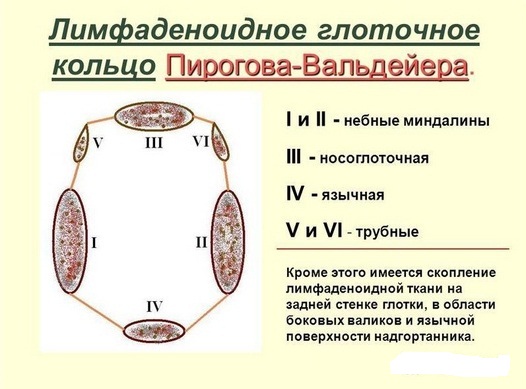
Six almonds together form a lymphoid pharyge ring.
Mind functions are as follows:
- protection of the upper respiratory tract from pathological microorganisms
- immunity formation
- blealing
In fact, almonds are the first immune barrier that the microbes pass with the air into the children's body. And every time the child is caught up or grabs ORVI, the areas of lymphoid tissue in its nasopharynx and the oral cavity are physiologically increasing, and then decrease as they are recovered.
But due to certain reasons, in particular, due to the permanent attack by pathogenic microorganisms, hyperplasia occurs (the development) of the lymphoid tissue of the sky and nasopharynk almonds. Last pathology and called adenoids.
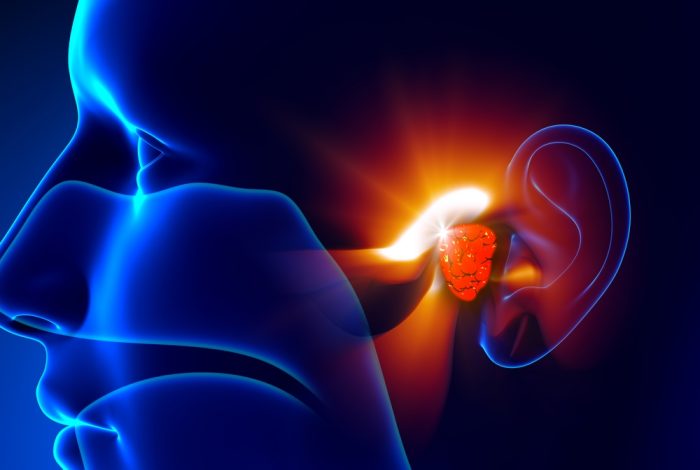
Adenoids are increased nasopharynk almond.
Adenoids, usually manifest in children 3-14 years old, but today this problem is often discovered in the kids of 1-2 years. It is due to two intersecting factors:
- A child from 1 year is no longer protected by the immunity of the mother, its own is formed.
- From this age, the child is in society, and after he begins to attend a children's team (garden, school, mugs, other). It is constantly in contact with the pathogenic microflora.
IMPORTANT: Doctors also talk about the inheritance of adenoids: if one or both parents in childhood there was an increase in the sky almond, the likelihood of pathology and in a child was considered.

Adenoids - the cause of frequent diseases in children is 3-14 years old.
Inflammation and hyperplasia of adenoidal (lymphoid) tissue is an inadequate protective reaction of the organism: it is trying to withstand infection with an increase in the number of cells of immunity - lymphocytes.
As a result, immunity does not improve, but only falls - the outflow of lymphs is disturbed, its wagges occur, the increased almond itself becomes the source of inflammation and the "seedler" of bacteria. They can easily "roam" in the cavity of the nose, the incomplete sinuses, hearing aisters, a throat, trachea and even bronchi. A child with adenoids has a chronic hearth infection in the body.
Degree of adenoids in children: 1, 2, 3
Doctors otolaryngologists distinguish three degrees of adenoids.
1 degree -Limfoid tissue on a third blocks the rear holes of the nasal strokes. This often occurs due to its inflammation during the rhinitis caused by the virus. A child is hardly experiencing any inconvenience with breathing. The mouth is breathing occasionally, during sleep.
2 degrees - Lymphoid fabric on half blocks the rear holes of the nasal moves. The child wakes up in a dream, often breathes his mouth and during the daytime.
3 degrees - Lymphoid fabric completely or almost completely blocks the rear holes of the nasal strokes. All the most characteristic signs of adenoids in children appear. When identifying this degree of pathology, it may be discussed about its surgical treatment.
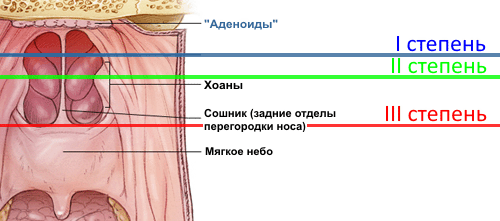
Degree of adenoids in children.
How to check adenoids in a child?
To see adenoids or check their condition, the parents cannot independently. Here you need a doctor - a specialist, a otolaryngologist. He can:
- Inspect the pharyngeal almond with a special mirror. Gunted mirror with a diameter of 0.5-1.5 cm on a long handle The doctor enters a child's soft sky. He can see if the adenoidal fabric increased?
- Send a child to x-ray. Method is old and low-informative. On the snapshot you can only see whether the pharyngeal almond is increased. But it is an answer to the question, she rushed or just inflamed, whether there is a pus on it, the X-ray will not give. Yes, and once again irradiated the child.
- Conduct endoscopic research. It will introduce a miniature chamber into the nasal course of the child on a thin tube, the image with which will be transmitted to the monitor. The method allows you to objectively assess the size, degree of swelling, consistency and the color of adenoidal tissue, put the correct diagnosis and choose the most reasonable way to treat adenoids. The lack of it is only that before the introduction of the endoscope, it is necessary to hold a child local anesthesia by spray - anesthetic.
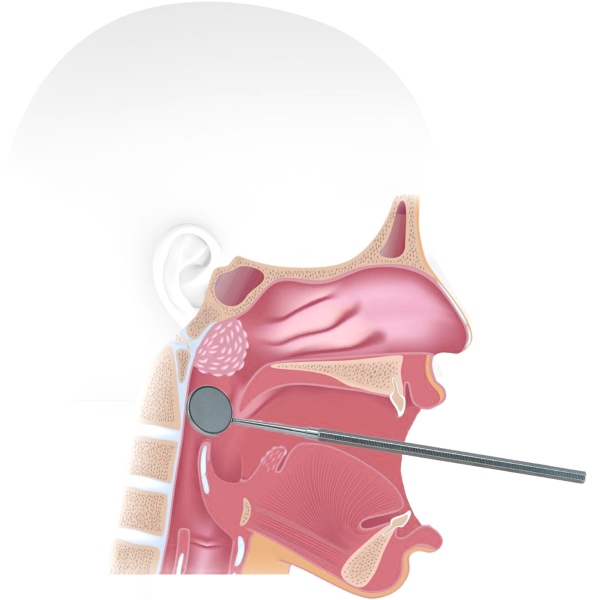
Inspection of adenoids with a gustral mirror.
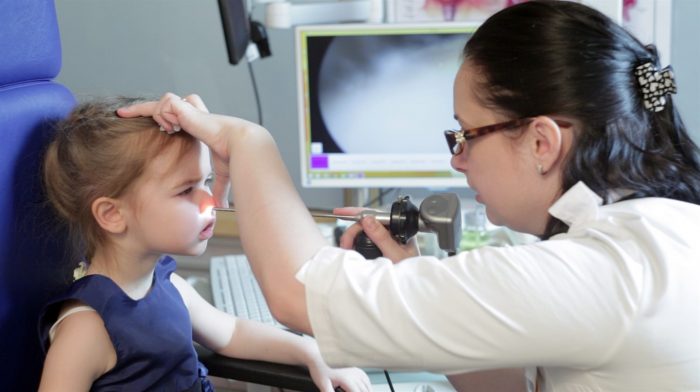
Endoscopy.
VIDEO: endoscopy of the nasopharynx degree of adenoids
How to determine, recognize adenoids in children: symptoms, signs
Usually, 1 degree adenoids are found in the child on the planned inspection of Laura. Either the reason for visiting this doctor is the complaints of parents for frequent and tightening diseases of the baby.

If the child sleeps with an open mouth and does not breathe a nose, perhaps he has adenoids.
2 and 3 degrees of adenoids in the child are drawn by such signs:
- His breathing through the nose is broken. During wakefulness, and more often in a dream, the child breathes his mouth. In this regard, his nights become restless: it snores, sniffs. The child may also happen to have a breathing delay - apnea. The child often wakes up in a dream. He can cough due to the drying of the throat or because mucus strokes from the nose.
- He often sick rhinitis, Sunusitis, otitis. Bacteria with the increasing pharyngeal almonds apply to the mucous membranes of neighboring organs, causing their inflammation.
- Hervi often goes bacterial complications - angina, bronchitis, pneumonia.
- The child begins to gnut.
- If adenoids have evolved in a child of preschool age, his speech can be formed incorrectly.
- Because of the constantly open mouth, the expression of the child's face is changing and becomes indifferent. In consequence, his bite may change, and the lower jaw stretches.
- Due to permanent breathing through the mouth, the child's brain is missing oxygen. Fancy, drowsiness, fast fatigue appear. The child can complain about headaches. His performance in school is reduced.

Adenoidal face.
Important: In order to prevent prevention, it is recommended to show children for 3-14 years in Laura annually. After all, lately identified and complicated adenoids can lead to persistent or irreversible consequences that the child will audit, even when he grows
Adenoids in infants: symptoms
The arrangement of lymphoid fabric of pharyngeal almond in infants is extremely rare. Usually, we are talking about its magnification in size due to inflammation, which is successfully treated with conservative methods.
Consult with a otolaryngologist will not hurt, if the infants:
- snoring or covered in a dream
- breathes mouth
- sleeps badly, wakes up apathetic
- because of the breakdown, it sucks badly, because of which it does not eat, does not get the weight
- he has serous and purulent discharge from the nose.
Adenoids in children causes: psychosomatics
Today, many specialists consider one of the reasons for adenoid psychosomatics, that is, the features of the personal development and thinking of the child, as well as the impact on his psyche from the outside.
So, pathology often detect in children:
- too impressive
- whose parents often quarrel or are divorced
- who feel the lack of love, feel unnecessary
- too closed
- who had a fright

Adenoids often find in children whose parents quarrel.
IMPORTANT: To facilitate the early cure of the child, parents must surround him care, more to delve into the "children's" problems, as well as to establish a favorable microclimate in the family.
Adenoids 3 degrees in children: delete or not?
A disconnection is only when adenoids have 2 or 3 degrees. And here the opinions of specialists diverge.
- some believe that it is necessary to eliminate the focus of infection
- others believe that it is impossible to delete immunity organ until the last
Read more about the testimony for operation and methods of its holding, you can read in the article:
Adenoids and Enures: Communication
On Enuresis, urinary incontinence, they say only in children who were 3-4 years old. By this age they are formed by the skill to keep urine in the bladder.
One of the reasons for the enuresis is called a violation of nasal respiration due to adenoids. Communication is explained by the fact that due to the conversion of lymphoid tissue in the nasopharynk, the outflow of venous blood from the ugeneous region deteriorates. Also suffers from the center of the brain responsible for the regulation of urination.
Cerented or remote adenoids often lead to the disappearance of Enurraw in children.
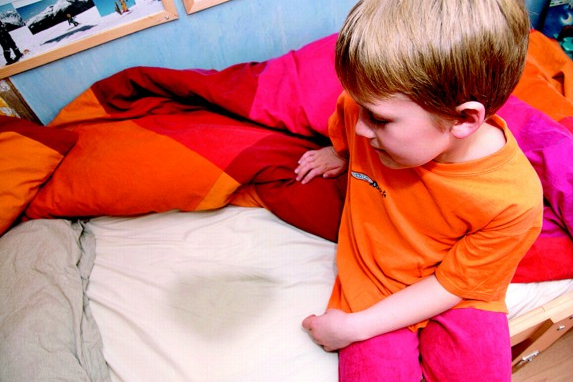
Enurperse is developing as a poor disruption of nasal respiration.
VIDEO: Bed-wetting
Allergies and adenoids: communication
The following connection was noticed between allergies and adenoids:
- Allergys often discover adenoids. Because allergic rhinitis is complicated by a bacterial infection.
- Allergic adenoids are not recommended, since it is high like that they will grow again.
- Allergy's adenoid removal is a prerequisite for the development of bronchial asthma.
How old are adenoids grow in children?
Until the maximum level of adenoids in children grow up aged 3 years to 7 years, decrease from 7 years to 14 years.
Is it possible to visit the pool with adenoids?
Visiting the pool is shown to children with adenoids, as:
- swimming harnesses and helps to strengthen immunity
- in the pool clean, warm, wet air
- swimming contributes to improved blood circulation
- swimming teaches a child to delay the breath (it has been proven that carbon dioxide contributes to the reverse development of adenoids) and breathe a nose

The pool helps cure adenoids.
